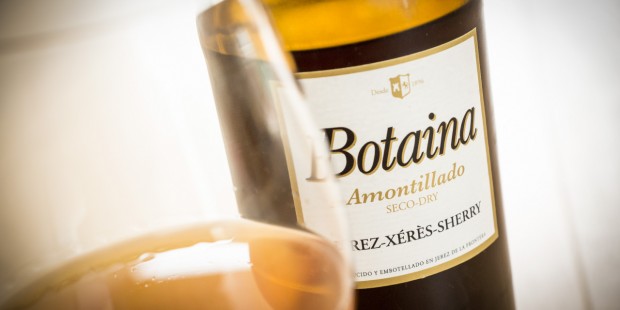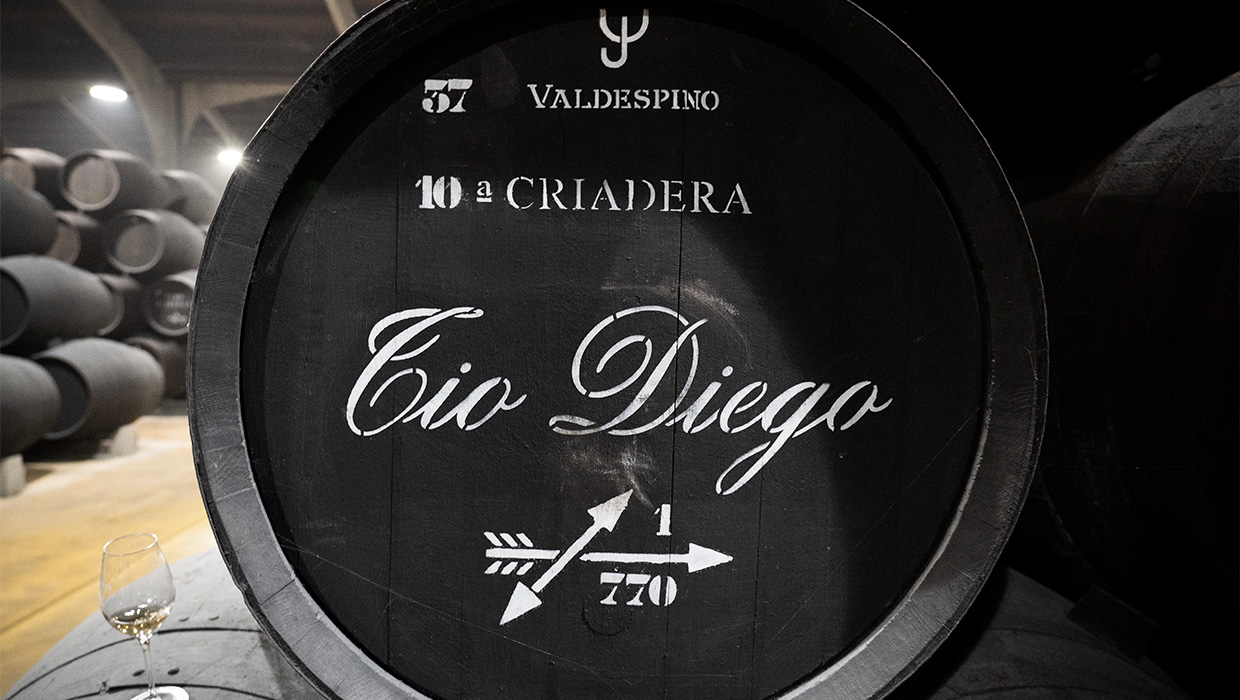
Amontillado
Amontillado sherry starts its life as a Fino or Manzanilla. At first it is characterized by biological ageing under flor, a layer of yeast that lives on top of the wine surface. After this initial maturation (usually two to eight years) a second period of maturation starts, exposed to oxygen (without flor). A cask of Fino is considered to be Amontillado as soon as the layer of flor stops developing. This can happen in a natural way, simply because there aren’t enough nutrients in the wine for the flor to survive. Most of the time though, the flor is intentionally “killed”, simply by fortifying the wine to above 17 degrees of alcohol.
Some of the most renowned Amontillados include Viña AB (Gonzalez Byass), Tio Diego (Valdespino) and Napoleon (Hidalgo)
There is a wide range of Amontillado styles. Some will display more flor character (sharper, leaner) while others will have a bigger influence of the oxidative phase (rounder, more pastry-like). The older an Amontillado gets, the stronger the wood influence will become. This can result in spicy notes and sometimes a leathery tobacco note. It is one of the most complex, refined styles of sherry.
Amontillado character
Amontillado oxidises in a slow and controlled way. It is exposed to oxygen through the slightly porous oak and gains a darker colour and richer flavour than Fino. While still having hints of flor, it will be less fresh and citrusy than a Fino but with more elegance and structure.
It is characterized by nutty aromas, tobacco, aromatic herbs and often ethereal, polished notes of oak. The fusion of two different aging processes makes Amontillado wines extraordinarily complex and intriguing and a wonderful wine to pair with food.
While Amontillado is a fundamentally dry style of sherry, it is often lightly sweetened for certain export markts. It is slightly higher in alcohol than a Fino: between 16º and 22º. The older it is, the higher the natural alcohol volume will be due to concentration and evaporation. As of 2012, the rules of the Consejo Regulador say that Amontillado should be naturally dry and can no longer be sweetened. Sweetend Amontillado can still produced but they should be labeled Medium / Cream sherry, sometimes with an addition like “Blend of Amontillado”.

A cask of Amontillado Tio Diego at Bodegas Valdespino
Types of Amontillado sherry
- Jerez Amontillado is sometimes used to designate the maturation in a bodega in Jerez de la Frontera.
- Manzanilla Amontillada is a Manzanilla in which the flor has died and which has been matured in Sanlucar.
- Amontillado del Puerto is an even rarer name for Amontillado matured in El Puerto de Santa Maria.
While there is a difference between Amontillado that originated from Fino and Amontillado that started as Manzanilla (which will have a more delicate body), this difference is rarely made on labels.
Sometimes the words Amontillado Fino are used to indicate a young Amontillado (in between Fino and Amontillado), as opposed to an Amontillado Viejo. However these labels are now prohibited by the Denomination of Origin, in order to avoid confusion. Old Amontillado can get a VOS / VORS classification to indicate a certified high age.
Appreciation
Amontillado is often considered the most complete and representative style of sherry since it displays qualities of both styles of maturation. It should be served at a higher temperature than biologically aged sherries (around 12°C, even warmer when it’s an old Amontillado). Amontillado goes particularly well with white meat, a beef consommé, chorizo, medium-heavy cheese or a paté.
Amontillado sherry reviews
- ‘As You Like It’ Amontillado blend (Williams & Humbert)4
- Almacenista Amontillado de Sanlúcar (Lustau)2.5
- Almacenista Amontillado del Castillo (Lustau)4.5
- Almacenista Amontillado del Puerto (Lustau)4
- Amontillado (Cayetano del Pino)4.5
- Amontillado (Dios Baco)4
- Amontillado (Gutiérrez Colosía)3.5
- Amontillado (La Cigarrera)3.5
- Amontillado 1822 (Argüeso)4
- Amontillado 1830 VORS (El Maestro Sierra)5
- Amontillado 2001 (Williams & Humbert)4.5
- Amontillado 2014 (Sacristía AB)4.5
- Amontillado 51-1a VORS (Osborne)4
- Amontillado 6|26 (Alexander Jules)3.5
- Amontillado 8 (Mar 7)3.5
- Amontillado Aurora (Yuste)4
- Amontillado Carlos VII (Alvear)3.5
- Amontillado Classic (Fernando de Castilla)3.5
- Amontillado Conde de Aldama (Contubernio)4
- Amontillado Cruz del Mar (César Florido)2
- Amontillado del Castillo (Lustau 125th Anniversary)5
- Amontillado Del Duque VORS (González Byass)3.5
- Amontillado Fino Fossi (Primitivo Collantes)3.5
- Amontillado Fossi (Collantes)4
- Amontillado Jalifa VORS (Williams & Humbert)4
- Amontillado La Honda (Osborne)5
- Amontillado Micaela (Barón)3.5
- Amontillado Napoleon (Hidalgo La Gitana)3
- Amontillado NPU (Sánchez Romate)4
- Amontillado Principe de Barbadillo4
- Amontillado Romate2.5
- Amontillado San Roque 30 (Sopla Poniente)4
- Amontillado Solera Familiar (Gutiérrez Colosía)4
- Amontillado Viña AB (González Byass)3
- Amontillado VORS (Bodegas Tradición)5
- Amontillado VORS (Harveys)4
- Amontillado VORS (Lustau)4
- Bertola Amontillado 12 Years (Díez-Mérito)4
- Botaina Amontillado (Lustau)4
- Colección Roberto Amillo Amontillado4
- Collection Amontillado 12 years (Williams & Humbert)2
- Cuatro Palmas Amontillado (González Byass)5
- El Cíd (Duff Gordon)4
- Fino Imperial Amontillado (Díez-Mérito)5
- La Bota de Amontillado n°31 (Equipo Navazos)5
- La Casilla Amontillado (Callejuela)4
- Moriles Viejo En Rama San Ramón (Bodegas El Monte)4
- Old sherry miniatures (part 2)
- Poley Amontillado 35 Years (Toro Albalá)4
- Quo Vadis? Amontillado VORS (Delgado Zuleta)4.5
- Royal Esmeralda Amontillado (Sandeman)4
- Tio Diego Amontillado (Valdespino)4
- Tio Guillermo Amontillado (Garvey)4
- XECO Amontillado
- ZEREJ II – Amontillado (Barbadillo)4










